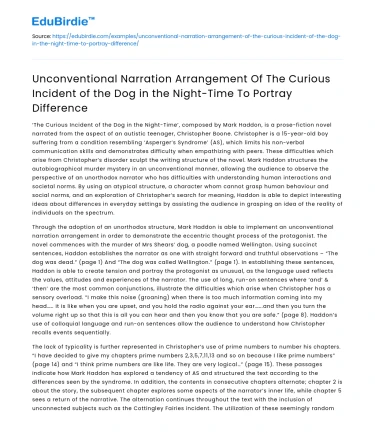‘The Curious Incident of the Dog in the Night-Time’, composed by Mark Haddon, is a prose-fiction novel narrated from the aspect of an autistic teenager, Christopher Boone. Christopher is a 15-year-old boy suffering from a condition resembling ‘Asperger’s Syndrome’ (AS), which limits his non-verbal communication skills and demonstrates difficulty when empathizing with peers. These difficulties which arise from Christopher’s disorder sculpt the writing structure of the novel. Mark Haddon structures the autobiographical murder mystery in an unconventional manner, allowing the audience to observe the perspective of an unorthodox narrator who has difficulties with understanding human interactions and societal norms. By using an atypical structure, a character whom cannot grasp human behaviour and social norms, and an exploration of Christopher’s search for meaning, Haddon is able to depict interesting ideas about differences in everyday settings by assisting the audience in grasping an idea of the reality of individuals on the spectrum.
Through the adoption of an unorthodox structure, Mark Haddon is able to implement an unconventional narration arrangement in order to demonstrate the eccentric thought process of the protagonist. The novel commences with the murder of Mrs Shears’ dog, a poodle named Wellington. Using succinct sentences, Haddon establishes the narrator as one with straight forward and truthful observations – “The dog was dead.” (page 1) And “The dog was called Wellington.” (page 1). In establishing these sentences, Haddon is able to create tension and portray the protagonist as unusual, as the language used reflects the values, attitudes and experiences of the narrator. The use of long, run-on sentences where ‘and’ & ‘then’ are the most common conjunctions, illustrate the difficulties which arise when Christopher has a sensory overload. “I make this noise (groaning) when there is too much information coming into my head…… it is like when you are upset, and you hold the radio against your ear…….and then you turn the volume right up so that this is all you can hear and then you know that you are safe.” (page 8). Haddon’s use of colloquial language and run-on sentences allow the audience to understand how Christopher recalls events sequentially.
Save your time!
We can take care of your essay
- Proper editing and formatting
- Free revision, title page, and bibliography
- Flexible prices and money-back guarantee
The lack of typicality is further represented in Christopher’s use of prime numbers to number his chapters. “I have decided to give my chapters prime numbers 2,3,5,7,11,13 and so on because I like prime numbers” (page 14) and “I think prime numbers are like life. They are very logical…” (page 15). These passages indicate how Mark Haddon has explored a tendency of AS and structured the text according to the differences seen by the syndrome. In addition, the contents in consecutive chapters alternate; chapter 2 is about the story, the subsequent chapter explores some aspects of the narrator’s inner life, while chapter 5 sees a return of the narrative. The alternation continues throughout the text with the inclusion of unconnected subjects such as the Cottingley Fairies incident. The utilization of these seemingly random topics in the novel elucidate Christopher’s unique thought process.
Additionally, the use of maths problems, times tables, maps and diagrams allow the narrator to portray a visual image of how his brain works. Christopher uses allusion for several logic and maths puzzles such as The Monty Hall Problem (page 78). The inclusion of these diagrams demonstrate how logical and ordered thinking gives Christopher comfort and stability. By altering the procedure of traditional novels, Haddon is able to portray the functionality of an individual on the spectrum. Therefore, Mark Haddon is able to explore interesting ideas about difference through Christopher’s eccentric writing style and narrative organisation, as well as inviting exploration of how Haddon has used an unconventional novelistic form to analyze the idiosyncrasies of Christopher’s condition.
In addition to the unconventional narration arrangement used, Mark Haddon explores Christopher’s search for meaning through a mid-text genre change. In doing so, Haddon is able to manoeuvre the novel from a classic murder mystery, to an unconventional tale about an insight into the life of a child with AS. This allows the audience to consider the aspect of non-linearity from a different viewpoint. As the novel progresses, a climatic resolution occurs in the middle of the text, when Christopher’s father, Ed, admits to not only the murder of Wellington, but to his masquerade of the truth regarding his ex-wife’s vacancy. The shift in the narrative represents Mark Haddon’s unconventional approach to the typical storyline, with more of an autobiographical approach. However, the denouement leads to Christopher seeking shelter from his father. “I had to get out of the house. Father had murdered Wellington. That meant that he could murder me.” (page 152). This passage sparked the beginning of Christopher’s plan to gain sovereignty and move to London with his mother. Christopher’s development is exhibited when he begins travelling, from page 168 to 233. During his journey, Christopher is able to catch public transport unsupervised, buy a train ticket, deal with police officers and interact with strangers in an attempt to reach 451c Chapter Road (his mother’s place). While his search for meaning was often diluted by his inability to read situations and understand societal norms, Christopher’s development and search for meaning ensured that he reached his destination. Haddon’s ability to divert the genre of the story mid-way through demonstrates not only the flexibility of the storyline but the abnormality and difference of the writing structure. The adoption of a distinct way of storytelling where Haddon uses a red herring to allow the narrator to find his search for meaning, effectively engages the reader. This allows Haddon to demonstrate the interesting ideas about difference by utilising an unconventional mid-text genre change.






 Stuck on your essay?
Stuck on your essay?

